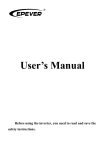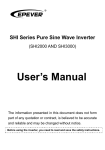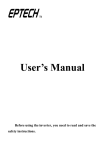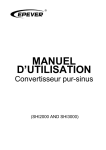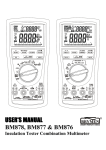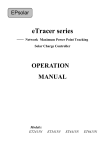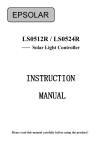Download User's Manual
Transcript
User’s Manual Before using the inverter, you need to read and save the safety instructions. SHI SERIES (SHI400, SHI600, SHI1000) Pure Sine Wave Inverter The information presented in this document does not form part of any quotation or contract, is believed to be accurate and reliable and may be changed without notice. CONTENTS 1. Introduction ................................................... 1 2. Important Safety Instructions ........................ 2 3. Inverter Operation ......................................... 4 4. Functions ....................................................... 5 5. Troubleshooting ........................................... 12 6. Maintenance and Warranty .......................... 14 7. Technical Specification ............................... 15 1. Introduction Thanks for purchasing SHI series inverters. The product is a pure sine wave inverter which can convert 12/24/48Vdc to 220/230Vac 50/60Hz based on full digital and intelligent design. It features high reliability, high efficiency, concise outline, small volume, full protection functions, easy installation and operation. The inverter can be applied in many fields, such as household appliances, electric tools and industrial devices etc, especially for solar photovoltaic power system. Features: Complete isolation-type inverter technology. Adoption of advanced SPWM technology, pure sine wave output. Dynamic current loop control technology to ensure inverter reliable operation. Wide DC input voltage range. Low output harmonic distortion(THD≤3%). LED indicators for input voltage range, load power range, normal output & failure state. Optional energy saving mode. The output voltage and frequency can be switched. Extensive protections: short-circuit, overload, under/over input voltage, over-temperature, and inverter‟s inner fault identification protections. Wide working temperature range (industrial level). Continuous operation at full power. 1 2. Important Safety Instructions As an AC power supply equipment, the inverter‟s output voltage is with the same level as that of household power plug. Mind the AC output terminals, or you may get an electric shock and result in life danger! Attentions: Connect the DC input according to the requirement strictly. The power inverter has a relatively wide input range, but too high or too low input may cause problems even destroy the inverter. The surge input voltage can‟t exceed 20V for the 12V inverters, 40V for 24V inverters, 80V for 48V inverters, or the inverters will be damaged. A reverse polarity connection will blow the fuses in the inverter and may damage the unit. Do not expose the inverter to humid, flammable, explosive or dust environment. Keep the inverter out of children touch. Inverter input is recommended to connect to battery, the min. capacity of battery(expressed in AH) should be calculated in the following way: 5times of the rated power of the inverter/battery voltage. If for testing purpose, user should select DC power supply current at least twice greater than that of the inverter rated input to keep inverter normal operation. Use DC power supply for testing may cause the damage of the inverter. When the inverter works continuously, its surface may became very hot, please make sure the air ventilation clearance around the inverter is more than 10cm. Keep away from the material or device which may suffer from high temperature when the inverter is working. Do not install the inverter in airproof location and keep enough space 2 around the inverter. The protective grounding must be connected to the ground. The cross section of wire should not be less than 4mm2. A fuse or breaker should be used between battery and inverter, the value of fuse or switch should be twice of the inverter rated input current. The wire connects between battery and inverter should be shorter than 3m, the current density should be less than 3.5A/mm2 while the output of inverter is fully loaded. If the wire longer than 3m, the current density should be reduced. Do not connect the battery charger or similar devices to the input terminal of the inverter. Do not put the inverter close to the flooded lead-acid battery because the sparkle in the terminals may ignite the hydrogen released by the battery. It‟s an off-grid inverter, if connect to the grid, the inverter may be damaged. This inverter can only be used singly, parallel connection or in series will damage the inverters. Do not attempt to repair the fault inverter yourself, otherwise it may lead to a serious accident. Please contact the manufacture‟s engineer. 3 3. Inverter Operation Connect the input and output terminals accurately. Turn on the power using the ON / OFF switch on the front panel. In order to avoid the protections resulted from the surge power, please turn on AC loads one by one after the output of the inverter is normal. Please check it as below: Set the power switch to the „OFF‟ position. Insert the load‟s plug into the inverter‟s output outlet. Connect the protective grounding to the ground. Make sure the fuse or breaker use between battery and inverter is off. Connect the battery („+‟ terminal with red line, „-‟with black line). Do not connect them by contraries, or the power inverter will be damaged. Switch on the fuse or breaker. Switch the inverter to ON and then turn on the loads one by one. Check the operation state of both power inverter and loads. „Green‟ of the failure LED indicator means the state is normal. If there are different loads, it is suggested that turn on the load with large startup current first, such as television, then turn on the load such as lamp when the inverter works stable. If the failure LED indicator is „Red‟ and the buzzer alarms or no output when you turn on devices, switch off the loads and power inverter immediately. Check the system by referring to the troubleshooting guide. Turn on the devices again according to the operation methods after the failure is removed. 4 4. Functions DC Input Panel DC Input Terminal Negative DC Input Terminal Positive Protective Grounding Fan Ventilatio n AC Output Panel Load Level Indicator Input Level Indicator Fault Indicator RS485 Port AC Outlet Mode Switch ON/OFF Switch 5 Switch Node The Optional Outlet Australia/New Zealand European 6 Input Level: Display Input Voltages LED Status 12V 24V 48V RED Slow Blink <10.5 <21 <42 RED 10.5~11 21~22 42~44 ORANGE 11~12 22~24 44~48 GREEN 12~14.5 24~29 48~58 14.5~16 29~32 58~64 >16 >32 >64 ORANGE Fast Blink RED Fast Blink Load Level: Display AC Loads LED Status AC Load ORANGE <20% GREEN 20%~75% RED >75% RED Slow Blink Overload RED Fast Blink Short Circuit Output & Fault Status LED Status Status GREEN Output Normal RED Fast Blink Overload or Short circuit, No Output RED Slow Blink Over or Low input voltage, No Output ORANGE Fast Blink Over temperature, No Output ORANGE OR RED Inverter Fault, No Output OFF Saving mode, Power Off,No Output 7 Alarms Alarms Status Overload or Short circuit, No Output Buzzer Sounds Over or Low input voltage, No Output Over temperature, No Output Inverter Fault, No Output The buzzer stops after 20S. 8 Protections Overload or Output Short Circuit Protection Overload Character 125% 150% 200% 230% >250% Continuance 60S 10S 1.5S <0.2S <0.01S Recover 3 times Space 5 seconds for the first time, 10 seconds for the second time, and 15 seconds for the third time If the overload or short circuit status still remains when the inverter tries to recover for 3 times, you should reduce or clear the loads and then restart the inverter manually. Load over than 250% will be treated as output short circuit. Input Low Voltage Protection The output is switched off when the input voltage is lower than low voltage protect value, and auto-switched on when the input voltage reach low voltage recover value. User can also manually restart the inverter to switch on output by the „ON/OFF switch‟, when the input voltage is higher than low voltage protect value. 12V 24V 48V Low Voltage Protect Value 10.8 21.6 43.2 Low Voltage Recover Value 12.5 25 50 Input Over Voltage Protection The output is switched off when the input voltage is higher than over 9 voltage shut off value, also the output is auto-switched on when the input voltage drops below over voltage recover value. 12V 24V 48V Over Voltage Shut Off Value 16 32 64 Over Voltage Recover Value 14.5 29 58 Fault Protection The inverter will shut down when the output voltage is error or when the inverter has inner fault. Over Temperature Protection The inverter will shut off when the internal temperature is overheating. And it automatic restarts when the temperature recovers to the normal level. Others Saving Mode When the switch is on “Saving” side, the inverter will enter into the Saving Mode. It will shut off the output if the loads value is less than 20VA. Then restart and detect the power of the load again after 10s. If the load is more than 20VA, the inverter will turn on the output .Otherwise it will shut off output again. It cycles like this. So please don‟t use the saving mode if the load is smaller than 20VA. 10 Mode Switch The output mode can be changed by the mode switch. When the switch No.1 is on the ON side, the inverter will enter into the saving Mode. This mode can be switched online. When the switch No.2 is on the ON side, the output frequency is 60Hz,otherwise is 50Hz. When the switch No.3 is on the ON side, the output voltage is 230Vac, otherwise is 220Vac. Both the output frequency and the output voltage change availability after restart the inverter. Switch Node The inverter can be control by the other equipment through the switch node. When the switch node is link, it equal to ON/OFF switch is on. The connection between the switch node and the ON/OFF switch as follow diagram: ON/OFF Switch NEG(-) POS(+) If need to use the switch node, a relay should be used. The rating current of the relay should not be less than 5A. The cross section of wire needs 1mm2. 11 5. Troubleshooting WARNING: High voltage is inside the inverter, do not open or disassemble it! Attempting to service the unit yourself may cause the risk of electrical shock or fire! Problem Possible Cause Solution Input LED blink, fault red LED slow blink Input voltage is too high or too low Measure the input voltage. The inverter recovers when the input becomes normal. Load LED blink, fault red LED fast blink Overload or load short Check out if the AC load is within the rated power or whether there is load short. Fault orange LED fast blink Over temperature inside the inverter Improve the quality of ventilation and do not block the vent. Restart the inverter when it is cool down. Fault red LED Inverter abnormal Remove all the connected plugs then restart. If inverter works well, please check the load and line. If the LED keeps red, the inverter has inside faults and should be returned to the factory. 12 Fault orange LED Inverter abnormal 13 Made sure the DC input terminals is tight, the input voltage between 10.8V and 15V (21.6~30V for 24V, 43.2~60V for 48V product) and restart the inverter. If the LED keeps orange the inverter has inside faults and should be returned to the factory. 6. Maintenance and Warranty The casing of the inverters may be cleaned regularly with a damp cloth (not wet) to prevent accumulation of dust and dirt. The screws on the DC input terminals must be tightened. The warranty period of the inverter is 2 year since the date of original shipping. Within the period, we will repair the product or replace the defective product for free. Return the defective with shipping cost prepaid. And provide proof of purchasing date. We will pay the return shipping charges within warranty period. The warranty doesn‟t apply under the following conditions: 1. Damaged by accident, negligence, abuse, improper use 2. Input voltage exceed the nominal input voltage of inverter 3. Unauthorized modification or attempted repair 14 7. Technical Specification Technical Data Types SHI400-12 SHI400-22 12V 24V Input Voltage Range 10.8 ~16Vdc 21.6 ~32Vdc No Load Current ≤0.8A ≤0.45A Nominal Battery Voltage Output Wave Pure Sine Wave Output Voltage 220Vac±3% / 230Vac±10% Continuous Power 400W Power 10 sec 600W Power 1.5 sec 800W Surge Power 900W Frequency 50/60Hz±0.2% Distortion THD ≤ 3%( resistive load) Efficiency at Rated Power Max. Efficiency ≥91% ≥92% ≥92% ≥93% Terminal 16mm2 Dimensions 280×166×74.3mm Installation 150×158mm Hole Size Φ5mm Net Weight 1.8kg 15 Types SHI600-12 SHI600-22 12V 24V Input Voltage Range 10.8 ~16Vdc 21.6 ~32Vdc No Load Current ≤0.7A ≤0.45A Nominal Battery Voltage Output Wave Pure Sine Wave Output Voltage 220Vac±3% / 230Vac±10% Continuous Power 600W Power 10 sec 900W Power 1.5 sec 1200W Surge Power 1350W Frequency 50/60Hz±0.2% Distortion THD ≤ 3%( resistive load) Efficiency at Rated Power Max. Efficiency ≥91% ≥92% ≥93% ≥94% Terminal 25mm2 Dimensions 295×186×82mm Installation 150×178mm Hole Size Φ6mm Net Weight 2.3kg 16 Types SHI1000-22 SHI1000-42 24V 48V Input Voltage Range 21.6 ~32Vdc 43.2 ~64Vdc No Load Current ≤0.45A ≤0.35A Nominal Battery Voltage Output Wave Pure Sine Wave Output Voltage 220Vac±3% / 230Vac±10% Continuous Power 1000W Power 10 sec 1500W Power 1.5 sec 2000W Surge Power 2250W Frequency 50/60Hz±0.2% Distortion THD ≤ 3%( resistive load) Efficiency at Rated Power Max. Efficiency ≥93% ≥93.5% ≥94% ≥94% Terminal 25mm2 Dimensions 295×208×98mm Installation 150×200mm Hole Size Φ6mm Net Weight 3.3kg 17 Environmental Parameters Working Temperature -20℃~+50℃ Storage Temperature -35℃~ +70℃ Humidity < 95%(N.C.) Altitude < 5000 m (Derating to operate according to IEC62040 at a height exceeding 1000 m) Others Insulation Resistance Between DC input terminals and metal case: ≥550MΩ; Between AC output terminals and metal case: ≥550MΩ. Dielectric Strength Between DC input terminals and metal case: Test voltage AC1500V, 1 minute Between AC output terminals and metal case: Test voltage AC1500V, 1 minute Version No. : V1.0 18 BEIJING EPSOLAR TECHNOLOGY CO., LTD. Tel: +86-10-82894112 / 82894962 Fax: +86-10-82894882 E-mail: [email protected] Website: http://www.epsolarpv.com/
























